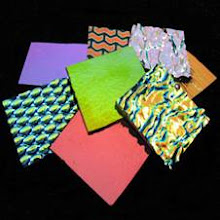| Glass fusing is the process in which a kiln is used to join together pieces of glass. When heat is applied to glass, it will soften. If you continue to apply heat, the glass becomes more fluid and will flow together. Two or more pieces of glass will stick (or "fuse") to each other. When glass of the same COE is heated and then cooled properly, the resulting fused glass piece will be solid and unbroken. Glass slumping is the manipulation of bending and shaping an already fused glass into or over a mold using the heat of a kiln to take on the shape of a bowl, a plate, or similar object. Other kinds of manipulation done with fusing techniques are combing, which involves using a tool to distort the shape of the glass while it is hot, and fire polishing, which uses a kiln to heat the glass just enough to make it shiny and smooth. . |
Typical Kiln Fusing and Slumping PROCESSES AND TEMPERATURES
| Process | Definition | Fahrenheit | Celsius |
| Full fusing | Joining two or more pieces of glass by heating until they flow together | 1450 to 1550 | 788 to 843 |
| Tack fusing | Fusing until the glass just sticks together, with each piece retaining its individual character. | 1350 to 1450 | 732 to 788 |
| Slumping | Shaping glass by bending it over or into a mold | 1200 to 1300 | 649 to 704 |
| Fire polishing | Heating glass just enough to round the edges and give it a shiny appearance | 1300 to 1400 | 704 to 760 |
Note that the temperatures given are for typical fusible art glasses.
Kilns and Glass vary and may require different temperatures.
DichroicAndMore.com carries a complete selection of Kilns and Glass Fusing Supplies

No comments:
Post a Comment